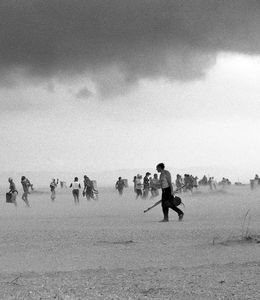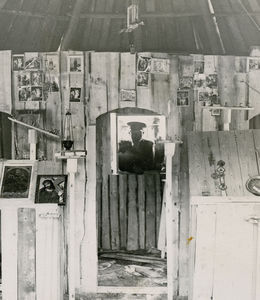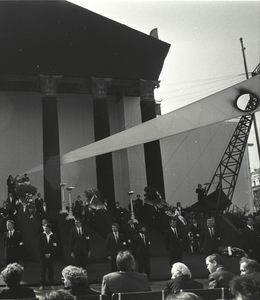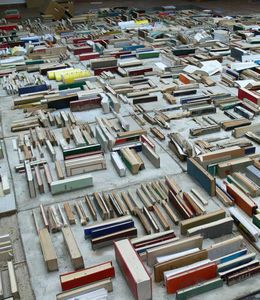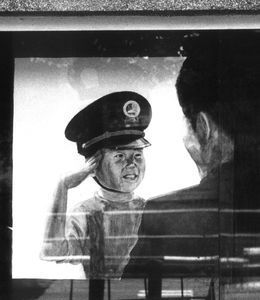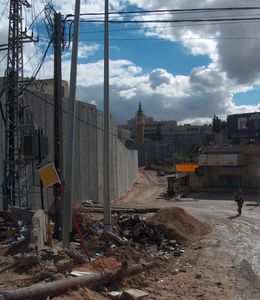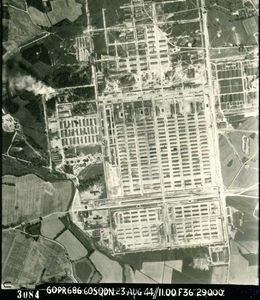Vera and Donald Blinken Open Society Archives
Virtual Exhibitions
For more than a decade, photographer Lenke Szilágyi (who has also been working as a photo-archivist in the Archives for a number of years) has regularly traveled to the (former) Soviet Union, witnessing and documenting the fall of Communism and Post-Soviet realities not only in large centers like Moscow or St. Petersburg but also in the provinces (the Black Sea coast, the Volga region, Karelia etc.). Her photos are sensitive imprints of an era of constant change and a territory of eternal immutability. She depicts in her portraits the hopes and despairs of the time, while also adding her own witty commentaries in the diary entries accompanying the photos. This exhibition is the first major presentation of this collection.
Lenke Szilágyi started her career as a documentarian of the Budapest underground in the 1980s: her unique...
This exhibition is about the ways in which Communist totalitarian states through secret police operations “captured” religion in images, graphics, texts and folders in order to control and eliminate those they deemed untrustworthy.
Faith and trust are two of the central foundations of religious community, but secrecy also represents a common feature of religions throughout history. The secret police, as their name suggests, depended on secrecy practices, whether real or simply performed, and as part of their undercover operations they sought to gain the trust of the communities they wished to infiltrate. Researchers of religion, both during Communism and today, also require the trust of the communities that they research, and they practice their own forms of secrecy to protect the identity of research participants...
This exhibit approaches the Fall of Communism from a broad historical perspective that presents the pre-history of the highly-visible and well documented public events of 1989, using amateur photographs, Western and Hungarian propaganda newsreels, Radio Free Europe research publications, state security services surveillance documents, samizdat and opposition activists’ materials, as well as 1989-related ephemera from our collections.
It opens just prior to the 1956 Hungarian Revolution, the thwarted popular attempt to leave the Communist bloc, and the secret trial, execution and burial of the Revolution’s leaders in 1958. We show how the Revolution was documented from multiple perspectives, and how its memory was officially denied and suppressed in Hungary, before being mobilized again in the 1980s by the democratic...
János Hübler and Nemere Kerezsi, two Ph. D. students at the Budapest Academy of Fine Arts (supervisor: György Jovánovics), have created this installation using two cubic meters of concrete and eighteen cubic meters of discarded books. Originally part of a large collection donated to the Central European University by Radio Free Europe’s research institute, the books, most of which had lost all relevance in the meantime, were offered to the public gratis. The eighteen cubic meters of books used for the installation are actually the leftovers, unwanted by the public. The two artists executed the project with the help of Márta Rácz. The books were built into a concrete foundation regardless of their content. Arranged with their spines pointing downwards, they constitute interesting shapes of various heights, due to their different sizes...
Among a range of interesting Post-Communist cultural phenomena, we have witnessed the emergence of what has been labeled the New Middle Ages by Umberto Eco. The resurrected Middle Ages in Hungary and East-Central Europe, however, exhibits different traits from West European festivals and spectacles. Above all, the phenomenon lies much closer to politics, sometimes with positive overtones, but, unfortunately, frequently with menacing, even destructive effects. Medieval monuments became a central battleground in the wars that marked the dissolution of Yugoslavia. And this is not atypical, political battles continue to be fought around medieval sites throughout the region. The centuries-old ruins of medieval fortresses and grand church edifices are being reconstructed, resurrected from the annals of history, to be turned into national...
This virtual exhibit supports one aim, the protection of freedom of expression and promotion of the free word. This project is supported by the Open Society Archives (http://www.osaarchivum.org), with the generous contribution of the Friit Ord Foundation (http://www.fritt-ord.no).
Public opinion, expression and thought are values constantly under threat. Restraining open communication and blocking access to information are the main means of manipulating public opinion and thought. In the defense of these fundamental freedoms, the Open Society Archive seeks to educate the public about the dangers of censorship, violations of freedom of expression and how these methods of control can be...
The exhibition stages the work of Normantas Paulius, a Lithuanian born photographer, traveller and researcher from Hungary. The approximately 190 photos taken over 20 years in 10 countries of the Far East will be exhibited in respect for Robert Capa.
The photographer comments:
"During humid Asian nights, I converse with vanished cities, their people and temples, with Buddhist treasures along the Mekong. They tell me about peace and war in these lands. As there had been more war, in the East I take more photographs of PEACE."
Words from Skirmantas Valiulis, famed Lithuanian photo critic:
"Photographer Paulius Normantas is a phenomenon: he does everything by himself, much of it in reverse. After his first exhibits, at a time when the Lithuanian school of photography had achieved sufficient renown both at home and...
Since the outbreak of the second intifada in September 2000, the number of Palestinian attacks against Israelis has grown significantly. In order to prevent the uncontrolled access of Palestinians from the West Bank into Israel and thus further attacks, the Israeli government decided in June 2002 to build a physical barrier along or near the Green Line (the 1949 Armistice Line). The planned route of the barrier, however, runs largely inside the West Bank, often on expropriated private land, imposing severe restrictions on the movement of Palestinians. In some cases, the barrier will turn Palestinian towns and villages into secluded enclaves and cut villagers off their farmland and water resources. And there are plans also for additional depth barriers and other obstacles to be built east of the main barrier.
The barrier is a 50-...
The Open Society Archives has arranged a series of programs on the occasion of the opening of the new Hungarian national exhibit, on the former site of the Auschwitz concentration camp. The opening of the Hungarian exhibit in Auschwitz coincides with the sixtieth anniversary of the beginning of the deportation of the Hungarian Jews, more than four hundred and thirty thousand of whom perished in Auschwitz, the epicenter of the Holocaust.
OSA has decided to reconstruct the first two official Hungarian Auschwitz exhibits, which opened on site during the time of Communist rule in 1965 and 1980, respectively. The two exhibits, in line with the official historiography, retroactively replaced the Jewish inmates with communist anti-fascist resistors in the camps; the Jews had been killed in Auschwitz, and their traces were lost...
The exhibition focuses on Stalin`s death, the mourning ceremony, the funeral and the fate of Stalin`s remnants afterwards. The exhibition does not want to deal extensively with the Stalinist personal cult, it`s role in the Soviet political system, and it's visual representation (mass propaganda, socialist realist art, etc.). Our task is to reconstruct the long moment of the dictator`s death - from the official announcement of his physical collapse until the replacement of his embalmed corps from the mausoleum. Stalin was the ultimate embodiment of a regime in symbolic as well as in a physical sense. The exhibit aims at presenting and analysing the effect of the vanishing of his figure on the public, and also the problems his decease raised for the regime and for his successors.
Besides the usual historical sources, (press and...


